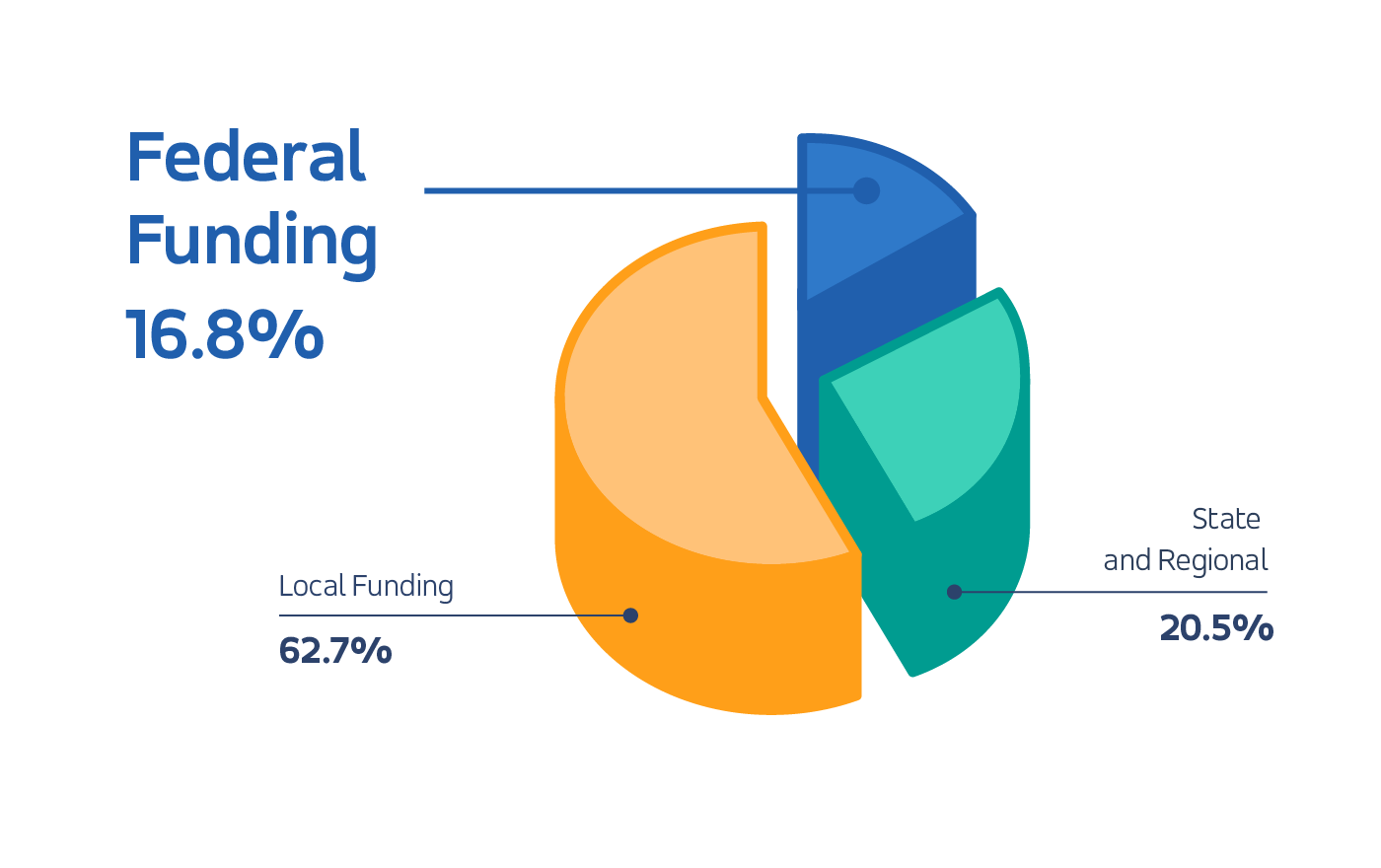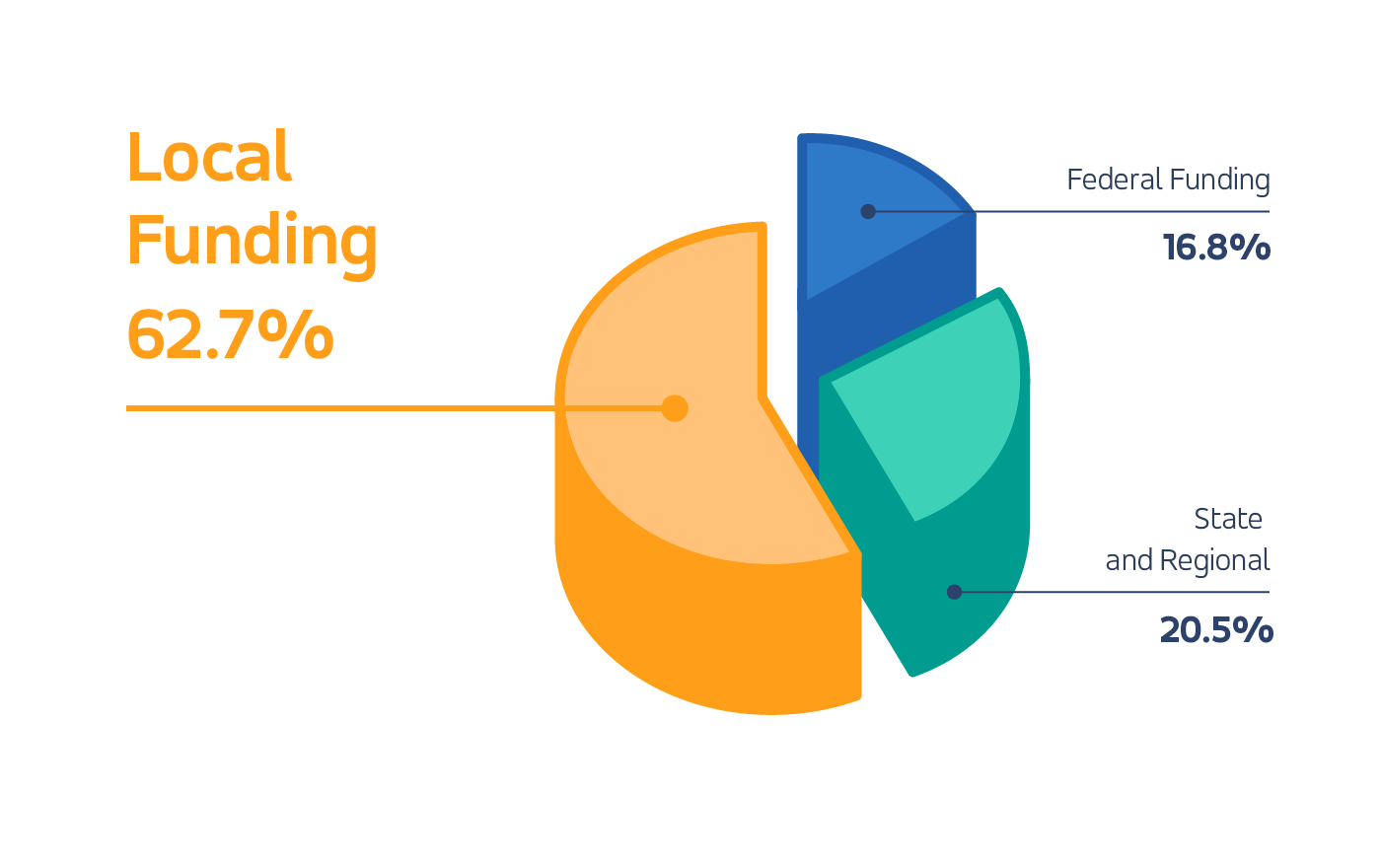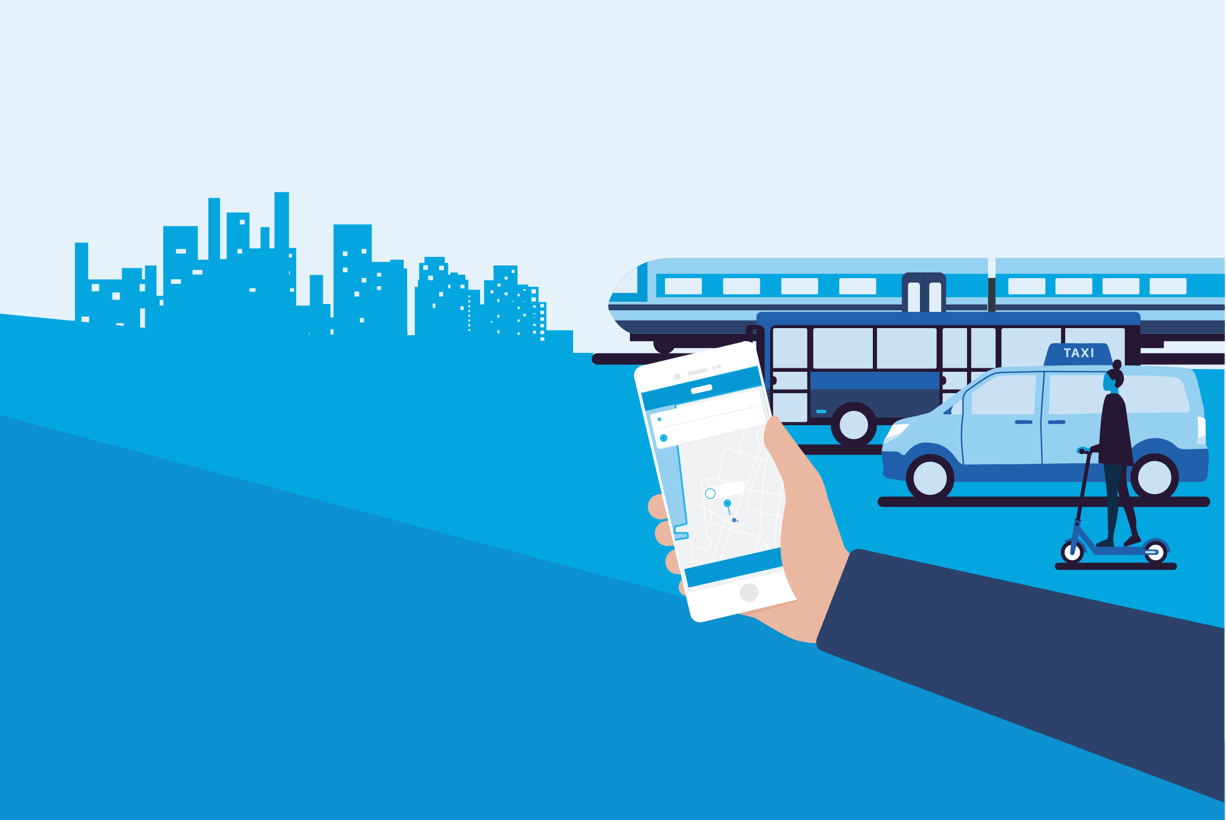Originally published June 29, 2020. Updated September 8, 2022.
Once considered emerging transit technology, microtransit — sometimes called on-demand transit — has become commonplace in transit systems across the country. Today, there are more than 100 microtransit deployments across 35 states in America, proving its consistently growing popularity amongst city leaders, transit authorities, and riders. But despite Frost & Sullivan predicting that microtransit shuttles will account for 50% of the shared mobility market by 2030, one of the biggest hurdles cities and transit agencies in the United States face is how to actually fund these technology-powered transit networks.
First, a little background: funding for public transportation is a highly localized combination of local and state taxes, federal funding, and fare revenue. Historically, federal funding has focused on capital expenditures like purchasing buses or constructing subway stations. State funding is a bit more of a mixed bag, but often also focuses on capital projects.
That’s one main reason most cities and transit agencies use local sources of revenue to fund on-demand microtransit, which is characterized by very light capital costs, and therefore often requires funding that can be spent more flexibly. Thankfully, over the last couple of years, agencies and cities have developed a number of other ways to fund projects. As policies at the federal and state level continue to evolve to account for innovative transit and its benefits, the pool of available resources will almost certainly grow over time.
Below, we’ve listed a number of ways communities are funding their microtransit dreams, breaking them down into three buckets: federal, state, and local.

Tapping into federal funding to power microtransit.
Despite federal funding accounting for only 16.5% of overall public transit funding in the United States, it has been an important element in launching several microtransit projects across the country. Federal funding mainly comes in two forms:
- Formula funds, which are typically distributed through the states, and then eventually trickle down to transit agencies based on area population, existing transit service, and some other factors.
- Competitive grant programs that are open to transit agencies, as well as cities and states.
Federal formula funds.
The Federal Transit Administration (FTA) began recognizing microtransit as public transportation in 2016, allowing formula funds to be used towards microtransit projects. This option is only available to transit agencies or cities that receive federal formula funds. Unfortunately, many cities and smaller transit agencies don’t typically receive formula funds. But for those transit agencies that do, formula funds can be a great resource for microtransit projects.
Making the best use of formula funds will look different depending on a transit agency's preferred approach to contracting and service delivery. In many cases, transit agencies want to operate their own microtransit services using an existing pool of vehicles and drivers. What they need is to license the technology and software to power such a service. Licensing software is considered a capital cost and was covered at up to an 80% match with federal formula funds.
Other transit agencies deploy microtransit by contracting with a private provider to operate the whole service — what some call a “turnkey” solution or “transportation as a service (TaaS).” In this arrangement, agencies could apply the FTA’s "capital cost of contracting ” policy and receive up to 80% match for half of a turnkey contract’s cost — in other words, 40% of the overall contract. In small urban and rural communities (defined as any community under 200,000 in population), the remaining half of the contract was treated as an operational cost and could receive up to 50% in federal match — or 65% of the overall contract.
Federal competitive grants.
Over the past four years, the Department of Transportation launched a number of innovation grant programs aimed at helping transit agencies and cities across the US experiment with new technology. Via has partnered with several cities and transit agencies on successful grant applications through these programs to launch new microtransit services. Seattle launched its successful “Via to Transit” microtransit deployment using federal funds from FTA’s Mobility on Demand (MOD) Sandbox Program. The program was later renamed the Integrated Mobility Program (IMI) and provided $20M to 25 projects in 2020, including microtransit projects in Arlington, TX , Baldwin County , and the Tidewater region of Virginia. The City of Wilson, North Carolina and the Delaware Transit Corporation both won Accelerating Innovative Mobility (AIM) grants to launch on-demand services.
Make sure to sign up for email updates on the FTA website to find out when new grant programs are launched and applications open. We also try to post any relevant notices on our blog.
Other federal grant programs provide opportunities for microtransit funding, such as the Congestion Mitigation and Air Quality Improvement Program (CMAQ and the ATTIMD Program (Advanced Transportation Technologies & Innovative Mobility Deployment) (ATTIMD, previously ATCMTD), which was funded with $60M for 2022. These grant programs may be a useful resource for microtransit and integrated services that reduce congestion. Additionally, the passing of the recent Infrastructure and Investment Jobs Act (IIJA) added multiple new transportation programs that include funding for microtransit. This includes the Carbon Reduction Formula Program, which allocates $1.2 billion annually to states and MPOs, as well as the Rural Surface Transportation Program and the Congestion Relief program which offers funding for microtransit projects in rural and urbanized areas, respectively.
We expect to see more grant opportunities for certain innovative mobility programs in the future as the Biden Administration continues to look to projects that advance equity and reduce greenhouse gas emissions. More to come! 
Federal programs that cover local match.
Any community receiving federal funds will need to find a local match to fully finance their project. While most communities find their local match in their local budgets, there are some federal programs that provide funding that can serve as a local match or source of additional funding. The FTA outlines these programs in an FAQ. They include transportation assistance programs from the Older Americans Act and Temporary Assistance for Needy Families (TANF) .
How state and regional funding comes into play.
While federal funding coughs up only 16.5% of overall public transit funding in the US, state funding accounts for another 21.2%. A collision of factors is leading state and regional governments to rethink how they create sustainable funding for transportation infrastructure. Federal funding for transportation has decreased over the years. Additionally, efficient fuel standards and electric vehicles have meant diminishing returns on state gas taxes. As a result, states have to be creative about their funding sources and mechanisms for innovative transit programs.
State transportation grants.
Several states offer transportation grants specifically for innovative transit services, while other grant programs focus on policy objectives, like reducing greenhouse gas emissions or increasing access to jobs. In both cases, a proposal to deploy microtransit can make for a compelling application.
- The Rail and Transit Division of Massachusetts Department of Transportation provided $4.2M in grants in 2020 for “projects aimed at meeting workforce transportation needs around the Commonwealth.” Through this program, the Worcester Regional Transit Authority (WRTA) in Westborough, MA received a $460,000 grant to pilot a public-private, on-demand shuttle service.
- In Florida, the Service Development Program funds projects that feature a “new or innovative technique or measure that can be used to improve or expand public transit services.”
- California’s Cap-and-Trade auction proceeds fund a number of programs that provide grants for innovative, sustainable, and equitable transit including $17M in grants for Clean Mobility Options and $22M for the Sustainable Transportation Equity Project (STEP) from the California Air Resources Board (CARB) and $146M in funding for the Low Carbon Transit Operations Program (LCTOP) and the State of Good Repair Grants (SGR) from CalTrans.
Congestion pricing, TNC fees, and tolling.
Some state, regional, and local governments are searching for new ways to raise funds for public transit. When New York State passed its congestion fees for taxis and ride-hailing vehicles entering Manhattan, it committed to spend some of the revenue on first/last mile improvements in the outer boroughs. The following year, New York State passed comprehensive congestion pricing for New York City. Once implemented, this program will raise significant funds for fixing and improving transit in the city. Perhaps the most interesting dynamic tolling scheme in the nation over the last few years has taken place in Northern Virginia on I-66. With money raised from those tolls — which vary depending on the time of day and current conditions — the I-66 Commuter Choice Program provides funding for expanded transit services and access to transit improvements, including microtransit projects.

Getting local: funding microtransit with ballot measures and partnerships.
Local funding accounts for the majority of transportation funding in the United States — a whopping 62.3%. Local sources include transit fares, local government budgets, ballot measures, and local partnerships. As local funding sources are constantly in flux, microtransit is an attractive option for cities and transit agencies because it’s so flexible — it can be scaled up and down to meet demand and resource constraints.
Below are a few creative ways to raise local funds.
Ballot measures.
Transit ballot initiatives provide opportunities for local communities to raise dedicated funding for transportation through voter-approved sales or property tax increases. In 2019, over $8B in new transit funding was approved in elections across 80 ballot measures, and in 2020 voters approved 13 out of 15 transit initiatives providing $38B in transit funding. This is great news despite a tough year for other transit initiatives. Many ballot measures were delayed as organizers decided that last fall was not the right time to ask voters to support even a small tax increase.
Microtransit made some history this past November. The City of Austin put a compelling, comprehensive transit vision forward and voters overwhelmingly approved it. Prop A — the first transit ballot measure in the nation to specifically fund microtransit — will enable CapMetro to expand its Pickup service to 15 neighborhoods with $4.5M per year in funding starting in 2023.
Local partnerships.
Last, but not least, take a look at forming local partnerships. Some local leaders have explored creative alternatives to tax revenues in order to fund their transportation services, and have partnered with key stakeholders in their community — from corporations to foundations to universities — to come together to solve transportation issues.
For example, the City of Birmingham partnered with the Community Foundation of Greater Birmingham to fund and launch an on-demand pilot program aimed at providing affordable transit in low-income communities. In other communities that have launched on-demand services, Via is working with our local partners to determine which employers benefit the most from the service so that we can encourage them to support the service financially. Have other funding ideas we may have missed, or looking for any help with securing funding of your own? Let’s talk!




